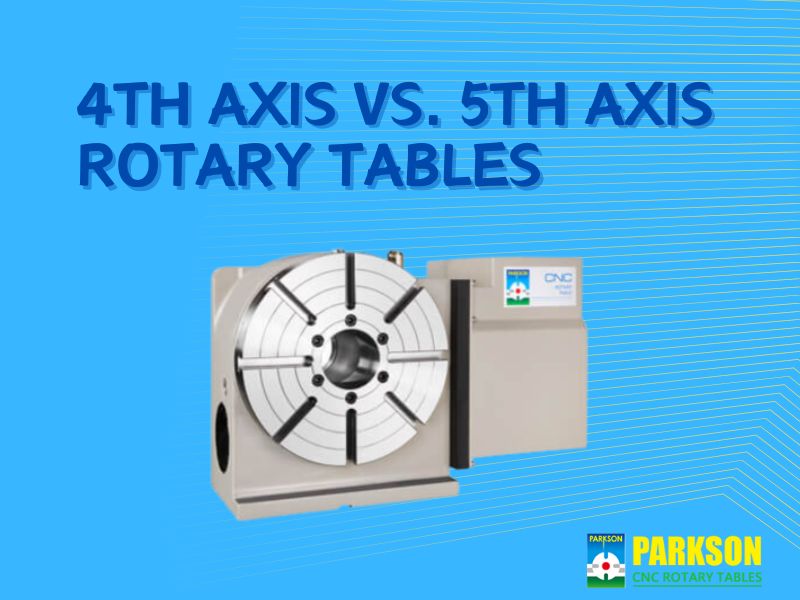
In modern CNC machining, rotary tables play a crucial role in increasing precision, efficiency, and versatility. Whether you're working with a 4th axis rotary table or a 5th axis rotary table, understanding their differences and applications can help optimize your machining processes. In this article, we’ll explore what these rotary tables are, their advantages, and how to choose the right one for your needs.
What is a 4th Axis Rotary Table?
A 4th axis rotary table adds rotational movement to a CNC machine's X, Y, and Z axes, allowing the workpiece to rotate around one additional axis (usually the A-axis or B-axis). This makes it easier to machine multiple sides of a part without manually repositioning it.
Key Features of a 4th Axis Rotary Table:
- One additional rotational axis (A or B)
- Improves efficiency by reducing manual workpiece repositioning
- Increases accuracy for machining features on multiple sides
- Commonly used for indexing and contouring
- Compatible with 3-axis CNC machines to add extra flexibility
Applications of 4th Axis Rotary Tables:
- Gear cutting and machining
- Engraving cylindrical workpieces
- Drilling and slotting multiple faces of a part
- Indexing operations where precise rotation is needed
- Manufacturing turbine blades and helical gears
What is a 5th Axis Rotary Table?
A 5th axis rotary table further enhances CNC machining by adding an additional rotational movement, allowing the workpiece to rotate on two different axes simultaneously (A and B or A and C). This enables full multi-sided machining in a single setup, improving efficiency and precision.
Key Features of a 5th Axis Rotary Table:
- Two additional rotational axes (A & B, or A & C)
- Allows for full 5-axis simultaneous machining
- Reduces the need for multiple setups and manual part repositioning
- Enables machining of complex, freeform shapes
- Ideal for industries requiring high-precision, multi-surface machining
Applications of 5th Axis Rotary Tables:
- Aerospace components (complex turbine blades, engine parts)
- Automotive industry (high-precision molds, engine blocks)
- Medical devices (intricate implants and prosthetics)
- Complex die and mold manufacturing
- Cutting tools and high-end mechanical parts
Comparison: 4th Axis vs. 5th Axis Rotary Tables
| Feature | 4th Axis Rotary Table | 5th Axis Rotary Table |
| Rotational Axes | 1 (A or B) | 2 (A & B, or A & C) |
| Machining Complexity | Moderate | High |
| Setup Time | Requires repositioning for some operations | Minimal repositioning needed |
| Machining Efficiency | Faster than 3-axis machining | Maximum efficiency with full multi-sided machining |
| Precision Level | High | Very High |
| Applications | Indexing, gear cutting, engraving, drilling | Aerospace, automotive, medical, and complex mold machining |
| Cost | Lower | Higher, but justifiable for complex parts |
How to Choose Between a 4th Axis and a 5th Axis Rotary Table
Choose a 4th Axis Rotary Table if:
- You primarily need indexed rotations for machining multiple sides
- Your parts require cylindrical engraving or drilling
- You want to improve efficiency without investing in a full 5-axis system
- Your workpieces do not have highly complex, multi-surface geometries
Choose a 5th Axis Rotary Table if:
- Your projects involve multi-sided, high-precision machining
- You need to create complex, freeform surfaces (e.g., turbine blades, aerospace components)
- You want full automation and fewer setups for high production efficiency
- Your industry demands extreme accuracy (medical, aerospace, high-performance automotive)
Why Choose PARKSON's 4th & 5th Axis Rotary Tables?
PARKSON provides a wide range of high-precision 4th axis and 5th axis rotary tables, designed for superior performance and seamless integration with CNC machines.
Key Benefits of PARKSON Rotary Tables:
- Zero-backlash direct-drive options for high-precision machining
- High torque and load capacity for machining heavy-duty parts
- Custom configurations available to fit various CNC setups
- Seamless integration with different CNC controllers
- Durable and reliable design for long-term productivity
Whether you need a 4th axis rotary table for efficient multi-sided machining or a 5th axis rotary table for advanced, high-precision applications, PARKSON has the right solution for you.
Conclusion
Both 4th axis and 5th axis rotary tables enhance CNC machining capabilities, but choosing the right one depends on your machining complexity, precision needs, and budget. A 4th axis rotary table is great for indexed machining and rotational cutting, while a 5th axis rotary table provides full simultaneous multi-axis control for highly complex parts.
Contact PARKSON today to explore our range of 4th and 5th axis rotary tables and find the perfect solution for your CNC machining needs!

